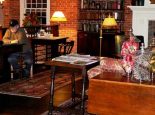The Common Man Inn & Restaurant in Claremont, NH was an ambitious project undertaken by Common Man owner Alex Ray and partner Rusty McLear of Hampshire Hospitality Holdings, which broke ground on May 28, 2008.
The Inn and Restaurant are located in what were defunct, historic mill buildings along the banks of the Sugar River in Claremont, which had fallen into disrepair as the area fell into an economic slump.
Alex and Rusty created partnerships with officials in Claremont, state agencies, Red River Computer Co. of Lebanon, NH and ReArch Company, LLC of South Burlington, VT. The team had a clear vision for the area - bring back the mills and reinvigorate the area's economy with jobs, growth and new businesses.
Painstaking care was taken to preserve as much of the historic buildings as possible and restore them to their original luster, with some modern technologies and improvements added to keep them moving forward.
In just over a year, Red River Computers and Common Man Inn opened their doors on June 5, 2009 in the historic Monadnock Mill #2 and #6. The Common Man restaurant opened a week later on June 12, 2009, across a newly-landscaped courtyard in the abutting Woven Label Building.
Monadnock Mill #2 was built in 1853 and was originally used for weaving and spinning cotton and linen textiles. Mill #6 was constructed in 1915 and is connected to Mill #2 on all floors. Mill #2 & #6 has received certification as a national historic building, and was renovated in accordance with preservation standards established by the National Park Service. Architects involved in the project included Chris Kennedy and Doug Sonsalla from UK Architects in Hanover, and Karollina Jablonska-Burtt of The Architectural Studio in Enfield.
When first built in 1909, the Woven Label Building was known as the Weave Shed of the Monadnock Mills Co. This two-story brick building was built to house 65 Jacquard looms for weaving bedspreads. It has a stone foundation, brick arched windows, and cast-stone lintels. A stone spillway runs under the building from east to west. In 1946, Claremont Woven Label Co. took over the building where it produced about 300,000 woven labels a day on Fletcher Jacquard looms.
Asked why they would undertake such a large project, Alex and Rusty, two leaders in New Hampshire's hospitality industry, said the Common Man Inn would satisfy a need in Claremont and provide a special experience. "Our studies indicated that the community could use more guest rooms to meet the needs of visitors and tourists in the area," said Alex. "The Common Man Inn rooms, located on the lower two levels of the Mill on the Sugar River and the top floor of the Woven Label building, make the Inn an interesting and unique destination."
John Illick of Sugar River Mills Redevelopment, LLC said the partnership with Red River Computer Co. and the Common Man was a critical element in the success of the project.
"A project of this scope needs more than a developer interested in renovating an historic building; it also requires businesses to occupy and participate in the process," said Illick. "It would have been very difficult to go through a historic review process to attain the preservation tax credits without knowing the use and architectural interests of the businesses that would operate in the Mill. The City of Claremont has also been an important part of this team, providing critical support from many of its departments as well as the needed public works projects in the mill area."
"Claremont only moves forward now, and we will never forget the confidence that this business team has placed in us," said Claremont City Manager Guy Santagate. "We welcome John Illick, Red River Computer Co. and the Common Man Restaurant and Inn, and thank them for becoming an integral part of our vision for the future of the City."
See the videos below which document the story of this project, from the vision to the transformation of the mill buildings into our Inn and Restaurant in Claremont. The Common Man family hopes to inspire other cities and towns to take a second look at their historical assets and explore opportunities to revive them.


